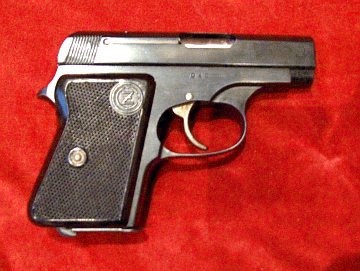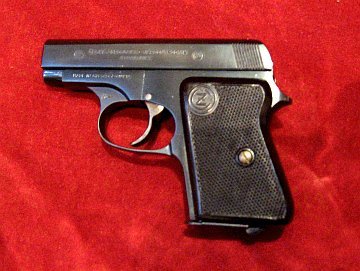

Side views of vz 45 pistol
The vz. 36 pistol, although patterned as a civilian pistol designed for personal protection, was used by both citizens and police during the period between World War I and World War II. Their production during this period was likely not very high; it can be very roughly estimated at 30,000 pieces. There are no large exports of this pistol known during the era before World War II. Although it was offered repeatedly, unsurprisingly those offerings did not inspire any interest. At this point in time, the global market was heavily saturated by pistols of this caliber. CZ attempted to generate interest in export sales by displaying a vz. 36 pistol (serial number 13,067) at the Poznan Fair in Poland in April 1938. Production of vz. 36 pistols was resumed during the year 1945 and continued until 1951, when it finally ceased. During this period, CZ concurrently manufactured the modernized version of the vz. 36 pistol, namely the CZ vz. 45 pistol. [Ed: It's not clear to me why they simultaneously manufactured both models.]


In the year 1945 the novel trigger mechanism of this pocket pistol was totally redesigned. The work was performed by inventors Jan Kratchovil and Vaclav Polanka. Their primary objectives were to simplify the manufacturing process for the pistol, and to improve its trigger pull. To simplify access to the trigger mechanism, the pistol was given a removable side plate, which was held in place by a countersunk screw on the right side and the trigger pin. The presence of this side plate can be used to easily distinguish the vz 45 [from the vz 36]; on the left side of the receiver [above the trigger] is an easily-noticed seam between the edge of the side plate and the receiver. Trigger pull weight was reduced via design modifications to the trigger mechanism. The trigger bar was doubled [it splits into two bilateral portions, like the 1911 trigger bar] and some of its forward movement in the receiver was removed, thereby reducing trigger bar angle, and thus trigger resistance. [To reduce wasted trigger takeup and trigger bar movement, the radial position of the cut via which the hammer interfaces with the trigger bar was moved forward. As a consequence, the amount of mainspring displacement in relation to the vertical axis of the hammer was changed, altering the spring pressure on the split trigger bar.] Another characteristic that distinguishes the vz. 45 pistol from the preceding [vz. 36] design is that the vz. 45 has only one barrel lug [instead of two as with the vz. 36], which locks into the receiver. The redesign of this pocket pistol also included the additional fitting of a magazine safety, which makes it impossible to fire a cartridge when the magazine is absent. This magazine safety is also present in some of the later production vz. 36 pistols.
The vz. 45 pistol is characterized by a variety of different markings on the left side of the slide. Specimens manufactured at Strakonice during the years 1945-1952 have the following text on the left side of the slide:
ČESKÁ ZBROJOVKA - NÁRODNÍ PODNIK and forward of this can be found the encircled company emblem, and on the opposite side of the legend is numerically marked with the caliber: 6.35 [also encircled]. Pistols manufactured in the year 1948 and later were stamped upon the left side of the receiver:
STRAKONICE
MADE IN CZECHOSLOVAKIA
The serial number of vz. 45 pistols is generally stamped upon the right side of the receiver over the triggerguard. After the termination of firearms manufacture at Strakonice, manufacturing was transferred to the primary branch of Ceske Zbrojovka at Uhersky Brod. Pistols made here are likewise stamped on the left side as follows:
ČESKÁ ZBROJOVKA - PRAHA
Forward of this was marked the traditional company emblem. On the opposite side of the legend was stamped a circle along with the caliber designation: 6.35.
Manufacture vz. 45 pistols began in the year 1945 and in the following year the MNO [Ministry of National Defense] ordered 11,000 of these modernized pistols not only for its own units, but also as personal sidearms, which could be obtained by officers and technical sergeants. The pistol was used as a personal sidearm by officers of the SNB [Sbor Narodni Bezpecnosti, or National Security Corps], members of CSD [Ceskoslovenske Statni Drahy, or Czechoslovakian State Railways] security, and was also used for many years by members of the Transportation Service Police [a division of Czechoslovakia Public Security (VB), the uniformed branch of police], who had the option of using a personal sidearm on duty, and who frequently preferred the CZ vz. 45 or vz. 36 pistol, Duo pistol, or the later model Z.
Exportation of vz. 45 pistols remains an uncharted region because not all records concerning their exportation have been found yet. Among known business transactions is the exportation of 100 pistols to Venezuela in 1948. This consignment was supplemented with 100 spare magazines and 20,000 6.35mm Browning rounds. The price of this consignment was $1,548.40 (77,420 Czech korun). In June of the same year, an order from Israel was fulfilled for 10 pistols along with 5,000 rounds of ammunition.
Based on known information, which remains fragmentary, it appears that 1949 was the peak of exportation of these pistols. In the course of that year, there were exports to 28 different countries, with total exports amounting to 8,289 pieces. Certainly the largest customer that year was India, which purchased 2,870 pieces. In second place was Turkey, with a purchase of 2,400 pistols. Smaller, but still significant, were purchases by Brazil (802 pieces) and Africa (presently South Africa), which received 625 pistols. Also that year, 347 pistols went to Venezuela, and to Kenya went 186 pieces. Invariably, exportation to patrons in overseas territories was far more fruitful than to those on the European continent. However, small export orders were fulfilled within the borders of Europe. Italy got 100 pistols that year, and the same number was exported to Holland, and to Finland was sent 99 pistols. To Switzerland and to Belgium went 50 pieces each, and 53 pistols were sent to England. A taller order, consisting of 157 pistols, was also exported to France.
The largest order ever sent to a customer was 7,000 vz. 45 pistols, which were ordered October 13, 1950 by the Hungarian firm Ferunion of Budapest. The pistols were dispatched February 14th of the following year, and the Hungarian firm paid 550 korun for each pistol, such that the total amount came to 3,850,000 korun. Simultaneously shipped to this firm were 200,000 rounds of 6.35mm Browning ammunition from the factory at Povazske Bystrici [Bystrice, Slovakia] at a total cost of 410,000 korun.
With the exception of the above instances, it is impossible to produce a summary of exportation of vz. 45 pistols, because there presumably were additional exports in later years. Much as with other Czechoslovakian pistols, exportation was not the subject of detailed records. After the discontinuance of firearms manufacture at Ceska Zbrojovka in Strakonice, manfacture of vz. 45 pistols was evidently transferred to a contemporary: the firm F. Dušek of Opočno, where the pistol was manufactured until termination of firearms manufacture at this factory in the year 1959. Opocno reportedly manufactured 205,000 CZ vz. 45 pistols during this brief period. However, this figure has thus far not been substantiated by any archival documents. In the early 1960's, vz. 45 pistols were manufactured at Zavodech Presneho Strojirenstvi (Precision Engineering Factory) of Uhersky Brod (formerly a branch factory of Ceska Zbrojovka of Strakonice), which is still in operation today.
While the trigger-cocking [double action] system invented by František Myška was used on three Czechoslovakian pistols (the CZ vz. 28, CZ vz. 36, and CZ vz. 38), the system slid into the oblivion within a few decades. However, Myška's renaissance inspired 80 years of technological development in the 20th century. The resulting system can be found today in the products of Smith & Wesson, Sites, Heckler and Koch, and Intratec. These firms, however, did not use the system in conjunction with the 6.35mm Browning caliber, despite the caliber being regarded as optimal for personal protection purposes for the first half of the 20th century. This view was later superceded by findings of the deficient stopping effects of the 6.35mm Browning cartridge and its less than optimal ballistic performance.
In modern self-loading firearms designed for personal protection, there is currently a trend toward greater use of a trigger-cocking [double action] system, which was invented in Czechoslovakia [That's a fact; contrary to popular belief, the "Little Tom", designed by Alois Tomiška, was the first double-action semi-automatic pistol ever, and not the Walther PP; Walther later copied the trigger-cocking idea (but not the design), merely making the Walther the first commercially successful semiautomatic]. The system itself offers undeniably fine reliability and safe function, its one negative property being the difficulty of achieving precise firing due to its long trigger pull and heavier trigger weight. Although the vz. 36 pistol itself garnered little interest at the time of its creation, its system remains quite relevant today.
One additional note: I found the following vzor 45 production figures on a Czech forum of some sort. I have no idea what the source of these figures is, so cite them with caution:
1946: 5,100 pieces
1947: 32,561 pieces
1948: 18,541 pieces
1951: 23,885 pieces
1952: 15,409 pieces
Email the Author
The author of this page can be reached at webmaster-at-freeexistence.org. Replace "-at-" with "@" in the "To:" line.
Reminder: All contents of this site, including translations, are automatically copyrighted by virtue of the Berne Convention for the Protection of Literary and Artistic Works. Further, the original untranslated content has been copyrighted by the text's original authors. Any attempts to plagiarize this content for inclusion in a trade publication article or book will be dealt with harshly!